
Choreographer’s Block and How to Overcome It
It happens to more than just writers.
I can’t tell you how many times I’ve stood in a dance studio, staring blankly at my feet, waiting for them to develop a mind of their own and tell me what comes next. Everything I try either feels awkward, doesn’t fit the music, is too repetitious, or just doesn’t flow. It’s frustrating as anything, especially when you’re up against a deadline.
Artists of all kinds experience creative blocks, which is good news, because it means that 1) you’re not alone, and 2) there’s a lot of good advice out there! In this article, I’m sharing some advice I’ve learned from writers and showing you how it can be applied to dance. I also give tips for how choreographers specifically can fight through creative dead zones.
Ready to overcome choreographer’s block? Me too!
Also read: How to Make Your Choreography More Creative
Why Do Creative Blocks Happen?
Figuring out why you’re feeling stuck can help you know what you need in order to get moving again. There are countless reasons why you might find yourself in a creative block, but most have something to do with energy.
Being creative takes energy. That could be physical energy, mental energy, or both. If you’re feeling tired or drained, it’s much harder to be creative.
That’s why most “how to overcome creative blocks” articles suggest taking a break from your creative project. Rest renews your energy so you can come back with a fresh mind and make progress.
But I know taking a break isn’t always an option. Maybe you’re choreographing for an assignment due tomorrow or a class you’re teaching later tonight. Or maybe this has been hanging over your head and you just need to get it done for peace of mind.
When you can’t take a long break, here’s the process I suggest:
- First, simply accept
that you’re experiencing a creative block. They happen to everyone, and telling
yourself to just get over it isn’t going to help. - Identify and name
the emotions you’re feeling. Are you distracted
by noise, phone notifications, or an unresolved issue? Are you frustrated that it’s not coming
together? Overwhelmed by the scope of
the assignment? Drained from
socializing or being alone? - Take those emotion
words and think about how to give yourself a burst of energy in that area. Make
a quick call to handle that unresolved issue. Think about how you could scale
down the project or tackle it in small chunks. Text a friend for a few minutes.
Order pizza. Whatever will resolve or soothe those specific feelings. - Try getting back
to the project!
Freeing Yourself from Perfectionism
It’s so hard, I know. It can feel impossible at times. I’m a perfectionist in every aspect of my life, and removing that lens from my dancing is something I struggle with a lot.
So what qualifies me to give you advice about overcoming perfectionism? While it’s not a skill I’ve mastered, it’s something I’ve spent a lot of time trial-and-erroring. I know that advice like “just relax and be yourself” isn’t helpful in the slightest. I know how a perfectionist’s mind works.
And let’s face it. Your journey to overcoming perfectionism will look different from mine or anyone else’s. The strategies I list here are merely suggestions that have been at least somewhat helpful for me. Some might work for you, others won’t.
The Sloppy First Draft
The actual name for this concept is “Shitty First Draft,” but I don’t like to say that word. Whatever you call it, it’s a concept that writers use to get that first draft down on paper without getting hung up on every little phrase. I think it translates perfectly to choreography.
It works like this:
- Ensure that no one will ever see your first draft. If
you want, don’t even teach your first draft choreography to your dancers. It’s
for you and you alone. This is important, because if you know people will see
it, you’ll want it to be perfect. Create your sloppy first draft in secret. - The ONLY objective
of your first draft is to get it done. If it’s a hot mess, but there’s a
beginning, middle, and end, you did it perfectly. There are supposed to be awkward transitions and
not enough levels and parts that don’t fit the music. It’s supposed to be a mess. If your first draft is your best, most
polished work ever, you did it wrong. This gives you the freedom to make
something less than perfect, but still feel like you’re “doing it right.” - Ignore the
“rules.” If you’re choreographing for a school assignment, there’s probably a
rubric you’re supposed to follow. Try to forget it for now. You can tweak your
project to fit the rubric on the second+ drafts. Even if you’re not getting
graded, you probably have a set of “choreography rules” in your head. Try to ignore
those, too. The first draft is just for you to get your ideas out there. - When your Sloppy
First Draft is complete (not before!), give yourself some gentle feedback. What
do you want to add, remove, or change? Make those adjustments. With all of this
work done, hopefully you will feel confident enough to show your work to other
people for more feedback.
Allowing yourself to create a Sloppy First Draft of your choreography can free you from needing it to be perfect the first time. You know no one is going to see it and judge it, and you can always make changes down the line.
Try These Ideas to Get Out of a Creative Rut
Witness Other Art
Watch, listen, read, play, just experience other people’s work. It doesn’t have to be dance. In fact, it probably shouldn’t be. The point is to take a rest from your project while simultaneously getting re-excited about art. You may find the perfect idea to integrate into your choreography, but don’t go looking for it. Just witness art for art’s sake and you’ll come back to your project refreshed.
Get Inspiration from Your Dancers
This won’t work for all situations. If you need the whole piece choreographed before rehearsals start, or if you’re choreographing for children, getting your dancers’ input won’t be practical. If you can, though, it’s a great way to move past a creative block.
- Have your dancers
improvise, film them, then go back through the footage and pick the movements
and phrases you like. - Have each dancer
come up with one 8-count, then work collaboratively to combine it all into one
big phrase. - Have your dancers
send in videos of their favorite dances or combos they’ve learned. Not only
will you get lots of material for inspiration, you’ll learn how your dancers
like to move. - If it’s a
yes-or-no, Option-A-or-B kind of situation, you could simply ask your dancers
for their opinion. If they understand the concept you’re going for, they should
be able to give informed advice. They’ll also be more invested in the piece
that way, because they had a say in its outcome.
You may feel like getting input from your dancers is cheating. It’s your piece, after all, shouldn’t you come up with all the choreography by yourself? Not necessarily!
Even if every phrase in your piece was generated by the performers, you still had your artistic hand in it by selecting music, picking formations and entrances, and putting the phrases together. It’s still your piece, you were just more of a director than a choreographer.
Repeat a Phrase with Modifications
Repeating a phrase is also not cheating. Done well, repetition can be an excellent choreographic device. It adds cohesion and causes the audience to recall different themes. The key is to never repeat a phrase verbatim.
Here are some ways to repurpose a phrase from earlier in your piece:
- Turn a group
phrase into a solo or vice versa. - Split the dancers
in half and have one group do the opposite side. - Switch up the
tempo. Do the whole phrase noticeably faster or slower, alternate throughout
the phrase, or have everyone do something different. - Switch up levels.
Change a floor phrase to standing or vice versa. - Retrograde.
Perform the phrase as if someone pressed “rewind.” - Cut the phrase in
half, then do the second half before the first. - Scramble the
phrase by putting the steps in a completely different order. (It barely even
counts as repeating if you do this!) - Repeat the phrase
with everyone facing different directions.
And these are just a few quick ideas off the top of my head. There’s so much more you can do to a phrase without coming up with a single new step of choreography!
Get Feedback
Have someone you trust take a look at what you have so far, and ask for their honest feedback. They may think of something you never thought of!
Add an Element of Chance
Pull a Merce Cunningham and solve your problem with a dice roll. Cunningham was known for leaving his composition up to chance: how many dancers onstage, how many counts to freeze, what music to use, etc. One way to utilize this might be to create a bank of 10-15 movements (i.e. rond de jambe or floor roll) and put them together with a random number generator. Modify or create transitions as necessary to make it work.
Work on a Different Part
Who says you have to choreograph from start to finish? If you’re stuck on the first phrase, try skipping ahead. Maybe choreograph a phrase backwards? Or try building a “movement vocabulary” for your piece that’s not set to any specific part of the music. Then use that vocabulary to create phrases as needed. The possibilities are endless!
How do you overcome choreographer’s block? Leave a comment below so others can see!
Also read: How to Make Your Choreography More Creative







